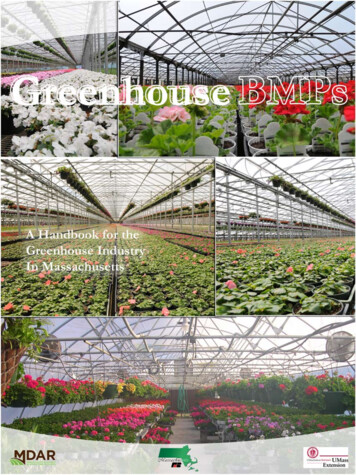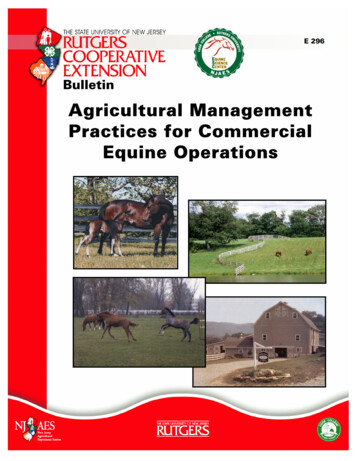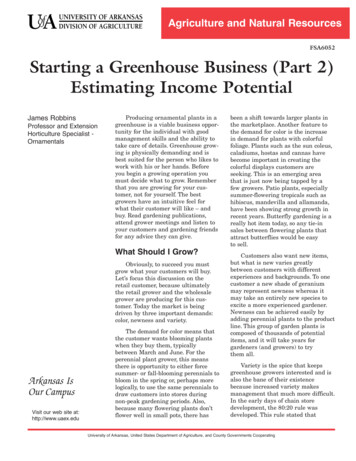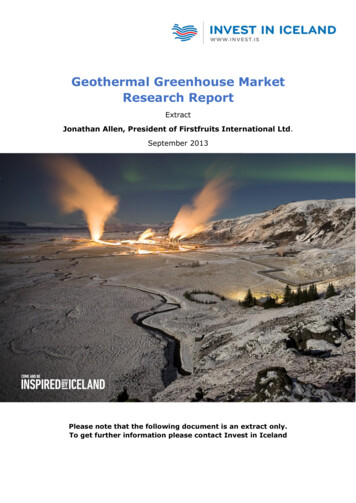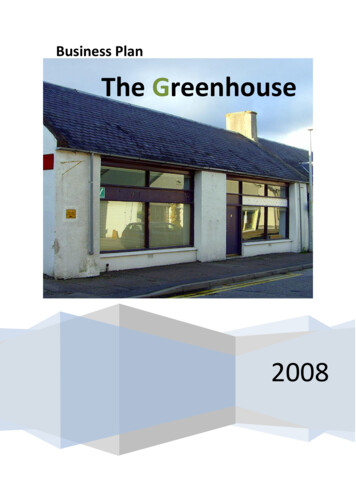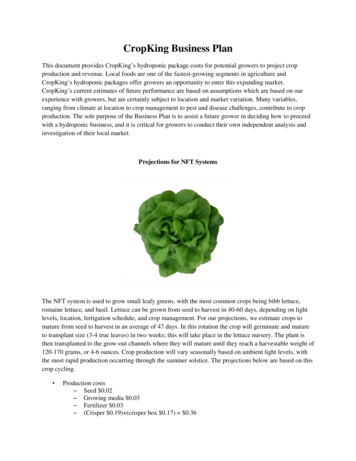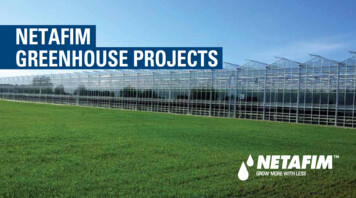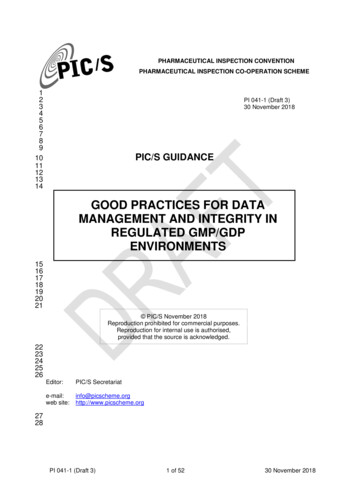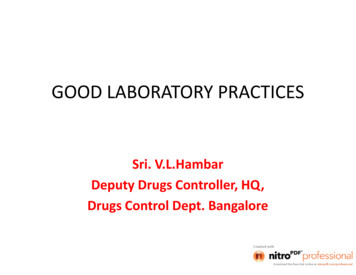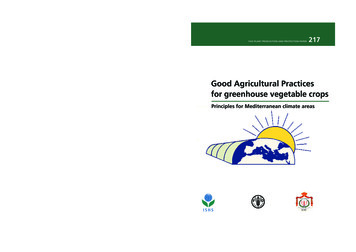
Transcription
I3284E-copertina-final.pdf103/06/201316:41:59FAO PLANT PRODUCTION AND PROTECTION PAPERMYCMMYCYCMYKISBN 978-92-5-107649-17 8 9 2 5 10 7 6 4 9 1I3284E/1/04.13Good Agricultural Practicesfor greenhouse vegetable cropsPrinciples for Mediterranean climate areasMinistry of AgricultureFAO9Good Agricultural Practices for Greenhouse Vegetable Crops - Principles for Mediterranean Climate AreasCThis publication capitalizes on the experience of scientists from theNorth Africa and Near East countries, in collaboration with experts fromaround the world, specialized in the different aspects of greenhouse cropproduction. It provides a comprehensive description and assessment ofthe greenhouse production practices in use in Mediterranean climate areasthat have helped diversify vegetable production and increase productivity.Guidance is provided on potential areas for improvement of greenhousecultivation. More specifically the document aims at strengthening technicalcapacity in the use of Good Agriculture Practices (GAP) as a means toimprove product quality and safety, and achieve sustainable productionintensification of greenhouse vegetables in countries in Mediterraneanclimate areas. The publication is also meant to be used as areference and tool for trainers and growers as well as otheractors in the greenhouse vegetables value chainin this region.217NCARE
MYCMMYCYCMYKFAO information products are available on the FAO website (www.fao.org/publications) and canbe purchased through publications-sales@fao.org.Produced with a contributionof the Belgian DevelopmentCooperation to FAO sHorticulture Facility
FAO PLANT PRODUCTION AND PROTECTION PAPER217Good Agricultural Practicesfor greenhouse vegetable cropsPrinciples for Mediterranean climate areasEditorial board:Food and Agriculture Organization of the United NationsPlant Production and Protection DivisionWilfried Baudoin, Remi Nono-Womdim, NeBambi Lutaladio, Alison HodderInternational Society for Horticultural ScienceCommission Protected CultivationNicolás Castilla, Cherubino Leonardi, Stefania De PascaleNational Center for Agricultural Research and Extension, JordanHorticulture DepartmentMuien QaryoutiEditorial support and layout:Ruth Duffy, English Language EditorFOOD AND AGRICULTURE ORGANIZATION OF THE UNITED NATIONSRome, 2013
The designations employed and the presentation of material in this information product donot imply the expression of any opinion whatsoever on the part of the Food and AgricultureOrganization of the United Nations (FAO) concerning the legal or development status of anycountry, territory, city or area or of its authorities, or concerning the delimitation of its frontiersor boundaries. The mention of specific companies or products of manufacturers, whether or notthese have been patented, does not imply that these have been endorsed or recommended byFAO in preference to others of a similar nature that are not mentioned.The views expressed in this information product are those of the author(s) and do not necessarilyreflect the views or policies of FAO.ISBN 978-92-5-107649-1 (print)E-ISBN 978-92-5-107650-7 (PDF) FAO 2013FAO encourages the use, reproduction and dissemination of material in this information product.Except where otherwise indicated, material may be copied, downloaded and printed for privatestudy, research and teaching purposes, or for use in non-commercial products or services,provided that appropriate acknowledgement of FAO as the source and copyright holder is givenand that FAO’s endorsement of users’ views, products or services is not implied in any way.All requests for translation and adaptation rights, and for resale and other commercial use rightsshould be made via www.fao.org/contact-us/licencerequest or addressed to copyright@fao.org.
iiiContentsAcknowledgementsPrefacevviiList of acronyms and abbreviationsx1. Regional Working Group on Greenhouse Crop Production in theMediterranean Region: history and development1A. Papasolomontos, W. Baudoin & N. Lutaladio2. Greenhouse site selection21N. Castilla & E. Baeza3. Greenhouse design and covering materials35J.I. Montero, M. Teitel, E. Baeza, J.C. Lopez & M. Kacira4. Greenhouse climate control and energy use63C. Kittas, N. Katsoulas, T. Bartzanas & S. Bakker5. Choice of species and cultivars for protected cultivation97C. Leonardi & A. Maggio6. Water requirements and irrigation management in Mediterraneangreenhouses: the case of the southeast coast of Spain109M. Gallardo, R.B. Thompson & M.D.Fernández7. Protected cultivation for improving water-use efficiency ofvegetable crops in the NENA region137A.F. Abou Hadid8. Microirrigation149G. Barbieri & A. Maggio9. Irrigation water quality for greenhouse horticulture169S. De Pascale, F. Orsini & A. Pardossi10. Soil fertility and plant nutrition205G. Gianquinto, P. Muñoz, A. Pardossi, S. Ramazzotti & D. Savvas11. Growing media271N. Gruda, M.M. Qaryouti & C. Leonardi12. Soilless cultureD. Savvas, G. Gianquinto, Y. Tuzel & N. Gruda303
iv13. Quality of planting materials355C. Kubota, A. Balliu & S. Nicola14. Cultural practices379Y. Tuzel15. Integrated pest management and plant hygiene underprotected cultivation399M. Abdel Wali16. Integrated pest management427A. Hanafi17. Integrated pest management and farmer education:FAO experiences from the Near East and the Maghreb511A.S. AlHawamdeh, M. Fredrix & A. Impiglia18. Harvest and post-harvest management529E.W. Hewett19. Integrated preventive environmental strategy ingreenhouse production565A. Antón & P. Muñoz20. Product safety581M. Allara, M. Fredrix, C. Bessy & F. Praasterink21. Labelling and certification: integrated farm assurancewith fruit and vegetable productionK. Patsalos603
vAcknowledgementsThis document is the result of a cooperative effort of a team of scientists whohave provided their voluntary contributions under the aegis of the FAO RegionalWorking Group on Greenhouse Crop Production in the Mediterranean Region.The genuine cooperation, professional commitment and dedication of the authors,co-authors, reviewers and collaborating scientists, as illustrated in chapter one, aregratefully acknowledged and most appreciated.Special recognition is given to the peer reviewer, Prof. Laurent Urban, Universityof Avignon, France. His diligence and detailed analysis of the text are highly valued.
viiPrefaceA very significant event in the world history of Agriculture is the domesticationof plants by mankind. Instead of depending on wild growth, it was realized thatthe planting of seeds or cuttings allowed the propagation of the type of plantsdesired. Another important breakthrough resulted from the need to protect thedomesticated plants from abiotic and biotic stress factors. Protected cultivationemerged as a way to protect crops from adverse weather conditions allowingyear-round production and the application of an integrated crop production andprotection management approach for better control over pests and diseases.Greenhouse crop production is now a growing reality throughout the worldwith an estimated 405 000 ha of greenhouses spread over all the continents. Thedegree of sophistication and technology depends on local climatic conditions andthe socio-economic environment.The experience of greenhouse production, which emerged in northern Europe,stimulated development in other areas, including the Mediterranean, NorthAmerica, Oceania, Asia and Africa, with various rates and degrees of success. It hasbeen shown that a mere transposition of north European solutions to other partsof the world is not a valid process. Each environment requires further research,development, extension, training and new norms of application to meet localrequirements.During the last 20 years countries in the Mediterranean climate area havebecome increasingly competitive producers of greenhouse vegetables. During thistime there has been a revolution in greenhouse production technology in terms ofgreenhouse design, type and quality of the plastic covering material, fertigation,mulch, use of high-yielding hybrids and cultivars, plant training and pruningtechniques, integrated pest management, the use of pollinator insects, climatecontrol, soil solarization etc. Only a few years ago, a yield of 100 tonnes per hectareof tomato in a greenhouse was considered a good performance. Today, for growersin Mediterranean climate areas, a harvest of 300 tonnes per hectare is not unusual.Besides supplying the local markets, the production of greenhouse vegetablesis greatly valued for its export potential and plays an important role in theforeign trade balance of several national economies in the Mediterranean region.However, the intensification of greenhouse crop production has created favourableconditions for many devastating pests and diseases. This has significantly increasedthe need for pesticide applications. At the same time, legislative measures andstandards requirements regarding the quality and safety of vegetables have become
viiiincreasingly demanding. Consumer awareness has risen and the demand forpesticide-free products is a reality which cannot be ignored.Since 1993, the Regional Working Group on Greenhouse Crops in theMediterranean Region facilitated by the FAO’s Plant Production and ProtectionDivision has supported training and research and development initiatives tostrengthen national capacities in upgrading the greenhouse crop sector inMediterranean climate areas. This publication builds on experience gained throughpartnerships forged by the working group and represents the interpartner effortof two decades. It aims to summarize the knowledge and practical experiencesof scientists from the Near East and North Africa region, specifically fromAlgeria, Cyprus, Egypt, Jordan, Lebanon, Libya, Malta, Morocco, the SyrianArab Republic, Tunisia and Turkey and in collaboration with the Commission ofProtected Cultivation of the International Society for Horticulture Science (ISHS)and a worldwide panel of subject matter specialists.This technical document intends to illustrate the benefits that can be drawnfrom an “integrated production and protection” (IPP) approach linking productiontechnologies and plant protection practices to minimize the use of pesticidesand adopting “sustainable intensification” of greenhouse crop production as theguiding principle. It is in line with the new FAO “Save and Grow” paradigm thathelps to limit agriculture’s impact on climate change and strengthens resilience ofopen-field and greenhouse farming systems to socio-economic and climate risks.It is believed that greenhouse crop production is destined to play an increasinglyimportant role in the Mediterranean climate environment as a means for sustainablecrop intensification leading to optimization of water-use efficiency in an environmentof water scarcity in addition to better control of product quality and safety, in linewith the market demand, standards and regulations.By sharing their knowledge and experience, the authors of this publicationwish to sustain the competitiveness of the vegetable greenhouse sector in theMediterranean climate areas and contribute to its further development to thebenefit of growers, consumers and the environment.This publication discusses the principles of Good Agricultural Practices (GAP)as they may be applied to greenhouse farming in the Mediterranean climate areas.It illustrates different aspects of greenhouse crop production and protection withspecial emphasis on greenhouse technologies, design and climate control, croppingsystems, in particular those practices which help reduce pests and diseases incidencein crops, integrated pest management, the use of adapted cultivars, and the need fortraceability and product labelling.
ixThe guidebook is expected to serve as a training guide for trainers and a resourcedocument for advanced growers and stakeholders of the greenhouse vegetablevalue chain. It is also a valuable source of information for programme managers,international and multilateral development organizations, NGOs and the privatesector – as well as researchers, advisors and professionals in greenhouse agriculture.We trust that it will help to further strengthen the work of the FAO-facilitatedRegional Working Group on Greenhouse crops in the Mediterranean Region.Abdessalam Ould AhmedFAO Assistant Director-General and Regional RepresentativeOffice of the Near East
xList of acronyms andabbreviationsAAPAir acidification potentialADIAcceptable daily intakeADPAbiotic depletion potentialAESAAgroEcoSystem AnalysisAFPAir-filled pore spaceAGNFAO Food Safety and Quality DivisionAGPFAO Plant Production and Protection DivisionALARIArid Land Agricultural Studies and Research InstituteAoPAreas of protectionARIAgricultural Research InstituteASABEAmerican Society of Agricultural and Biological EngineersASEANAssociation of Southeast Asian NationsATPAdenosine triphosphateBERBlossom end rotBSIBritish Standards InstitutionCAControlled atomosphereCBCertification bodyCECCation exchange capacityCEDCumulative energy demandCENEuropean Committee for StandardizationCFDComputational fluid dynamicsCGMMVCucumber green mottle mosaic virusCHPCombined heat and powerCIChilling injuryCMVCucumber mosaic virusCNLCompensated no leakageCPCCControl Points and Compliance CriteriaCVYVCucumber vein yellowing virusCWSICrop Water Stress IndexCYSDVCucurbit yellow stunting disorder virus
xiDEDelivery efficiencyDFTDeep flow techniqueDIFDay-night temperature differenceDTDay temperatureDTPADiethylene triamine pentaacetic acidDUDistribution uniformityDWCDeep water cultureEAWEasily available waterEBAEthylene butyl acrylateEBIErgosterol biosynthesis inhibitorECElectrical conductivityEDDHAEthylene diamine di-o-hydroxyphenylacetic acidEDTAEthylene diamine tetraacetic acidEPCElectronic product code identificationEPSEffective pore spaceETEconomic thresholdETcCrop evapotranspirationEToReference evapotranspirat
Greenhouse crop production is now a growing reality throughout the world with an estimated 405 000 ha of greenhouses spread over all the continents. The degree of sophistication and technology depends on local climatic conditions and the socio-economic environment. The experience of greenhouse production, which emerged in northern Europe,
